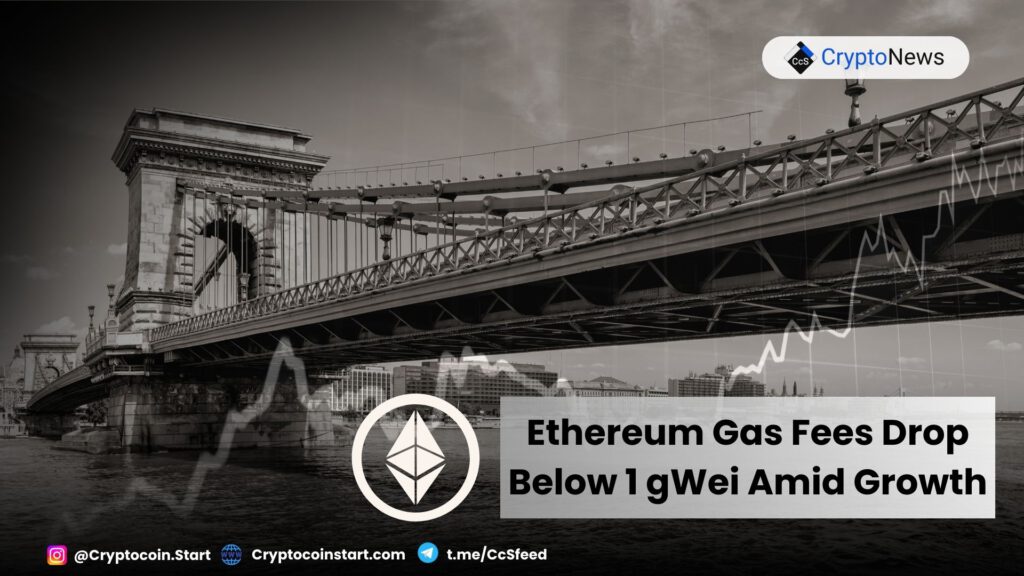
Ethereum Gas Fees Fall Below 1 gWei
Ethereum (ETH) has seen a significant drop in gas fees, with costs remaining under 1 gWei for several days. This trend is unusual, as such low fee levels have not been observed even during the most bearish periods for ETH.
Activity on the Ethereum network is currently low, leading to these reduced gas fees. On average, fees have recently fallen to as low as 0.57 gWei, although high-speed transactions may still incur higher costs. This dramatic decrease in fees has been a consistent trend since March 2024, representing an anomaly in Ethereum’s fee structure.
Gas fees on Ethereum can fluctuate, with occasional dramatic spikes even during otherwise calm periods. The current low fees reflect recent scalability efforts and the shifting of traffic to Layer 2 (L2) chains such as Arbitrum, Optimism, and Base. Despite these reductions, fees remain higher than in the early days of Ethereum, and even the bear markets of 2022 and 2023 did not see fees this low. Recent fee levels have not been observed since 2020.
It’s important to note that periods of low fees can sometimes lead to unexpected spikes, where even minor transactions may cost up to $200. Lower fees are not necessarily a barrier to using Ethereum but may indicate reduced interest in network activity. Speculative activities and decentralized exchange (DEX) trading have increasingly shifted to Solana and Base.
Impact of Low Fees on ETH Burning
While lower fees have made transactions more affordable, they also slow down the ETH burning process. ETH burning initially contributed to network deflation, but the current low fees have brought ETH emissions closer to neutral levels. To achieve the desired sound money narrative, a higher burn rate is necessary, but this goal conflicts with Ethereum’s scaling strategy by moving activities to L2 chains.
ETH inflation has recently increased to 0.74%, adding approximately 16,996 ETH to the supply each week, which could total nearly 1 million ETH annually. This inflationary trend is largely attributed to activity shifting away from the Ethereum mainnet to L2 chains.
Proposals have been made to improve ETH burning by increasing fees on L2 blob activities. Currently, blob economics only occasionally affect the burn rate as blob fees are directed to validator rewards rather than being burned. The proposed increase in blob fees aims to boost the burn rate and optimize block space usage on L2 chains.
Ethereum Records Value Outflows
In recent weeks, Ethereum has experienced significant value outflows, both in terms of ETH market price and shifts in protocol balances. Over the past three months, Ethereum has been a net donor to Arbitrum and other top L2 chains, with $1.4 billion flowing out of Ethereum in the form of wrapped ETH, ERC-20 tokens, and stablecoins.
This liquidity has largely been locked into the L2 ecosystem, making bridging back to Ethereum rare. As a result, most economic activity is now concentrated on L2 chains, which host native DEXs and DeFi platforms. Ethereum currently holds around $45 billion in value locked, down from a peak of $65 billion in May. The largest outflows have been from Lido and Eigen, primarily due to ETH market price declines. Eigen Layer, for example, has seen its value decrease to $11.5 billion from nearly $20 billion.
The Ethereum mainnet continues to maintain around 450,000 daily active addresses, reflecting stable activity levels over recent weeks. However, Ethereum’s market price has been affected by recent outflows and a broader downturn in the cryptocurrency market. ETH recently dipped to $2,471.25, coinciding with Bitcoin’s (BTC) dip to $57,000. Both cryptocurrencies are currently experiencing subdued sentiment, with potential for further corrections.

